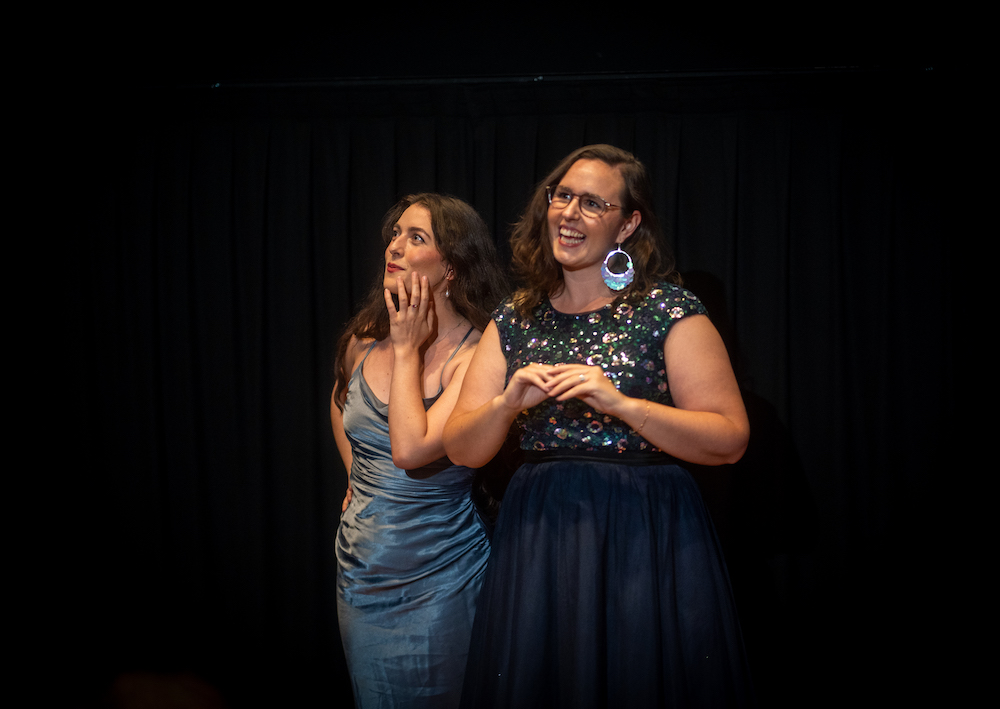Signing takes equal billing with singing in this unique production, delivering an enthralling and moving piece of theatre, writes Penny Shaw.
The singer and the signer in perfect harmony
18 February 2023
- Reading time • 5 minutesMusic
More like this
- Rewriting tradition with skill and charm
- Close encounter stirs the soul
- The great unknown
Contemporary Communication, Bloomhouse Projects
State Library of Western Australia, 17 February 2023
As we wait in the foyer of the State Library Theatre, it is clear from the amount of excited signing and the relatively hushed atmosphere that the deaf community is out in force for Contemporary Communication, a concert that explores what happens when all “voices” are treated equally.
The first thing I notice in the program is that Auslan advocate and former Young Australian of the Year, Drisana Levitzke-Gray, is billed as a performer alongside the musicians in some of the numbers, not just as an interpreter. Instead of Auslan being an aid to facilitate the deaf in a hearing world it is there in its own right.
Opening with the formidable Stravinsky and No Word from Tom, his aria from The Rake’s Progress, soprano Jenna Robertson keeps us enthralled with her excellent diction and pristine vocal control. Sharing centre stage is Levitzke-Gray, the two performers exchanging looks as they express the full emotional rollercoaster of the abandoned character Anne Trulove; the singer and the signer, side by side in perfect harmony.
There is comedy in miscommunication, regardless of language, and this is perfectly illustrated in Bernstein’s Oh Happy We from Candide. In this duet, the flighty Cunegonde is charmingly played by emerging artist Bella Marslen, and the practical Candide is signed by Levitzke-Gray, the lyrics displayed on the screen behind. Candide becomes increasingly exasperated with Cunegonde’s inability to understand him, while Cunegonde remains in blissful ignorance. Judging by the giggles from the audience, this is a universal problem, for the deaf and for the hearing.

After this, Marslen launches into an animated Hello! Oh Margaret, it’s You from Menotti’s The Telephone, showing off her excellent musicality and acting talents. Levitzke-Gray attempts to sign but gives up in comic disgust, explaining afterwards how excluded the deaf can feel when their hearing friends chat endlessly on the phone. Not just the deaf, I think to myself!
Next up pianist Lochlan Brown, on loan to his home town from the Dutch National Opera in Amsterdam, invites audience members to place their hands on the piano as he plays an exquisite Sein wir wieder gut from Strauss’s Ariadne auf Naxos. In the opera, the composer declares his fervent belief in the great art of music and, as seven unabashed members of the deaf community cluster around the piano and immerse themselves in the sound waves, we realise we don’t need words to believe the same.
Brown and Levitzke-Gray perform an enchanting rendition of Dvorak’s Song to the Moon from Rusalka, as it would have been expressed had the character lost her voice before the aria. I don’t think I am the only one to find the combination of Brown’s sensitive playing and Levitzke-Gray’s animated and anguished pleas extremely moving.
The finale brings us back to earth with Where from Miller-Heidke and Grandage’s evocative opera The Rabbits, finishing as we started with Levitzke-Gray sharing centre stage with Robertson.
Bloomhouse Projects’ Karl Brown and Daniella Sicari have done an incredible job, not only to sell so many tickets to an independent event in the midst of Fringe World and Perth Festival, but to have the vision to look outside the box and embrace collaboration and inclusivity.
Contemporary Communication is a unique piece of theatre, one that will remain and resonate. I, for one, am intrigued to see what Bloomhouse Projects does next.
Pictured top: Audience members gather around pianist Lochlan Brown to ‘hear’ the sound waves from the instrument. Photo: Sophie Hart Photography
Like what you're reading? Support Seesaw.





